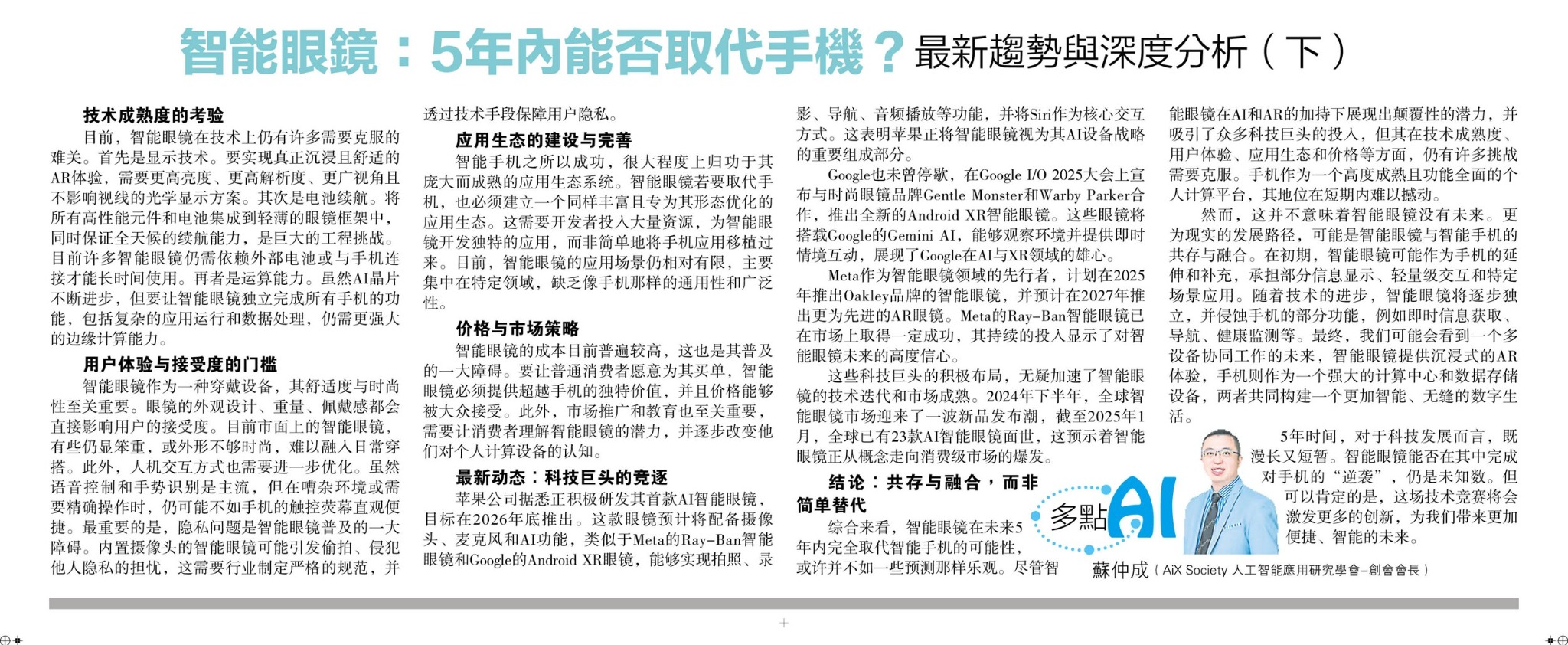Smart Glasses: Can They Replace Smartphones Within 5 Years? Latest Trend Analysis (Part 2)
THE CHALLENGE OF TECHNOLOGICAL MATURITY At present, smart‑glasses still face numerous technical hurdles. First is

THE CHALLENGE OF TECHNOLOGICAL MATURITY
At present, smart‑glasses still face numerous technical hurdles. First is the display. To deliver a truly immersive AR experience, the optical system must provide higher brightness, higher resolution and a wider field of view while remaining transparent enough not to obstruct the wearer’s vision. Second is battery life. Packing high‑performance chips and batteries into a lightweight frame that still powers the glasses all day is a huge engineering challenge; many products on the market still rely on tethered battery packs or smartphone connections for long‑term use. Third is computing power. Although AI chips continue to improve, letting smart‑glasses independently handle all of a smartphone’s functions – including running complex applications and processing data – will require much stronger edge computing.
BARRIERS IN USER EXPERIENCE AND ACCEPTANCE
As a type of wearable device, comfort and appearance are critical. The design, weight and feel of the glasses directly determine how willing people are to wear them. Many current models remain relatively bulky or insufficiently stylish to blend into everyday outfits. Interaction methods also need further refinement: natural language conversation and gesture recognition have improved, but they are still less efficient in noisy or outdoor environments. More importantly, privacy is a major barrier. Glasses with cameras raise concerns about covert recording and invasion of others’ privacy. The industry needs strict norms and technical measures to protect users and bystanders.
BUILDING AND IMPROVING THE APPLICATION ECOSYSTEM
The success of the smartphone was due in large part to its rich and mature application ecosystem. If smart‑glasses are to stand alone rather than be a smartphone accessory, they will also need an equally vibrant ecosystem of native apps. This will require developers to invest significant resources to create dedicated experiences; simply porting existing smartphone apps will not unlock the unique advantages of the form factor. Today the use‑cases for smart‑glasses remain limited and concentrated in a few verticals, lacking the universality and breadth of the mobile ecosystem.
PRICING AND MARKET STRATEGY
The cost of smart‑glasses remains high and is one of the biggest barriers to mass adoption. Current products target a high‑end niche, but to reach mainstream consumers their price must fall closer to that of phones, while also offering experiences that clearly surpass what a phone alone can provide. In addition to hardware cost, market education is crucial; consumers and developers must understand the value of this new category of personal computing device.
LATEST DEVELOPMENTS: COMPETITION AMONG TECH GIANTS
Apple is reportedly developing its own AI smart‑glasses with a target launch around 2026. The product is expected to integrate a camera and full AI features similar to Meta’s Ray‑Ban glasses and Google’s Android XR glasses, offering immersive AR visuals, navigation, audio playback and using Siri as the core interface. This indicates that Apple sees smart‑glasses as an important part of its AI device strategy.
Google has not been idle. At Google I/O 2025 it announced collaborations with fashion eyewear brands Gentle Monster and Warby Parker to launch a new Android XR smart‑glasses platform. These devices will integrate Google’s Gemini AI to sense the environment and provide real‑time contextual suggestions, showcasing Google’s ambitions in AI and XR.
Meta, an early mover in the field, plans to launch an Oakley‑branded AR glasses line in 2025 and a more advanced version thereafter. Its current Ray‑Ban smart‑glasses are the first mainstream AI glasses to achieve some success, and the continued investment shows Meta’s confidence in the category’s future.
These moves by the tech giants demonstrate a strong commitment to accelerating both the technology and the market. In the second half of 2024 and into early 2025 the global smart‑glasses market is expected to see another wave of product launches. By the end of 2025 several AI‑enabled smart‑glasses could be on the market, signalling the arrival of a consumer spring for the segment.
CONCLUSION: COEXISTENCE AND INTEGRATION RATHER THAN SIMPLE REPLACEMENT
Overall, smart‑glasses are unlikely to completely replace smartphones within the next five years, or at least the transition may not be as sudden as some forecasts suggest. A more plausible future is one of coexistence and integration: smart‑glasses will augment phones by delivering hands‑free information display, spatial navigation and audio experiences, while phones retain their more powerful processing, input and health‑monitoring roles. Ultimately we may see a multi‑device cooperative ecosystem: immersive AR headsets for work, smart‑glasses for heads‑up assistance, and the smartphone as the central hub for connectivity and data. Together they will form a more intelligent and seamless digital life.
Five years is both long and short in the context of technology development. Whether smart‑glasses can stage a “reverse takeover” of the smartphone remains uncertain, but the competitive race among tech giants is sure to spark more innovation and usher in a more convenient and intelligent future.
THE CHALLENGE OF TECHNOLOGICAL MATURITY At present, smart‑glasses still face numerous technical hurdles. First is
Over the past two years I’ve been particularly interested in one question: Which large companies
2025年7月15日,AiX Society 与香港奇墨網絡科技有限公司(以下称“奇墨科技”)正式达成战略合作。AiX Society 会长 Michael 和奇墨科技CEO吴翔分别代表双方签署合作协议。此次合作将充分发挥双方的行业资源和技术优势,共同推进全球企业核心业务和管理深度融合AI高质量发展。 AiX Society 专注于人工智能转型和大语言模型运营赋能,致力于通过全面的培训、咨询和战略合作伙伴关系,助力各组织充分发挥人工智能的潜力。 2025年7月15日,AiX Society 与香港奇墨網絡科技有限公司(以下称“奇墨科技”)正式达成战略合作。AiX Society 会长